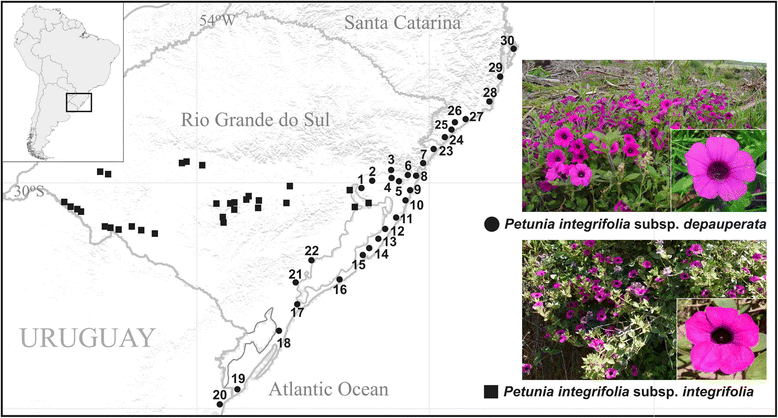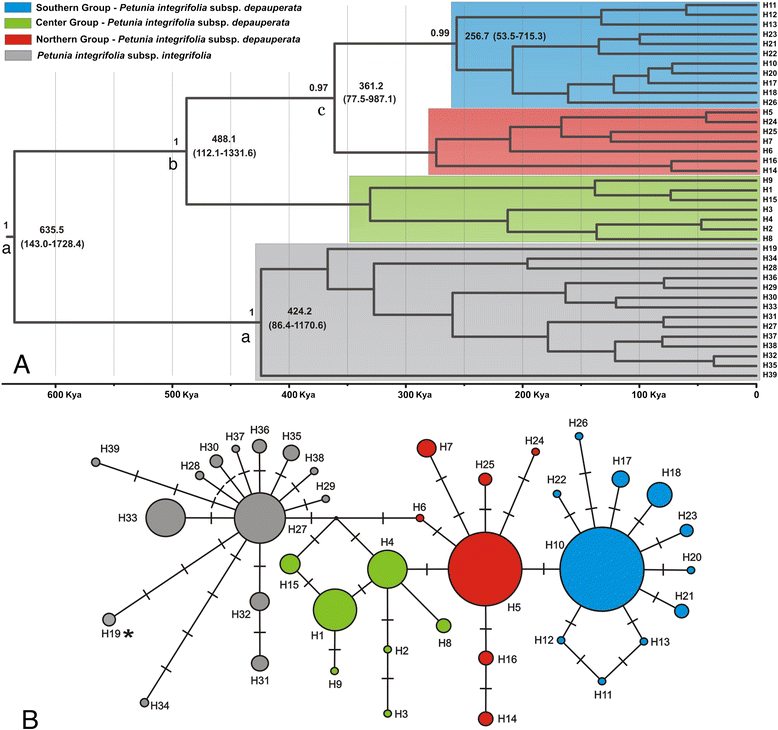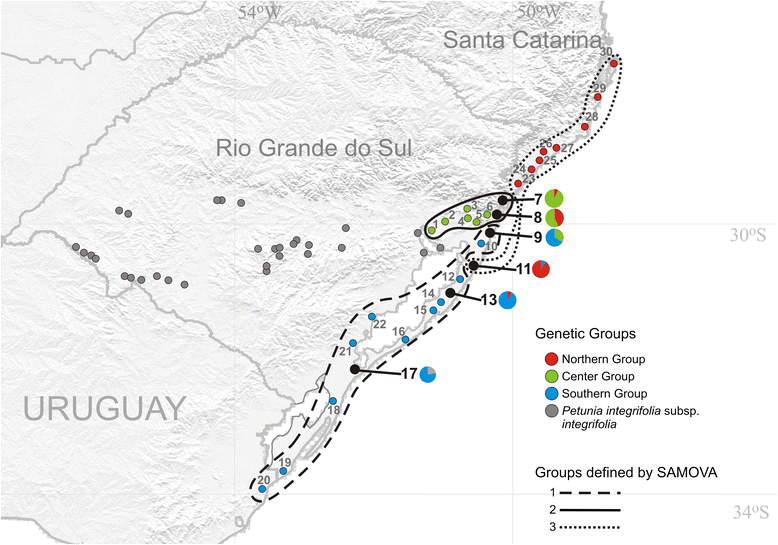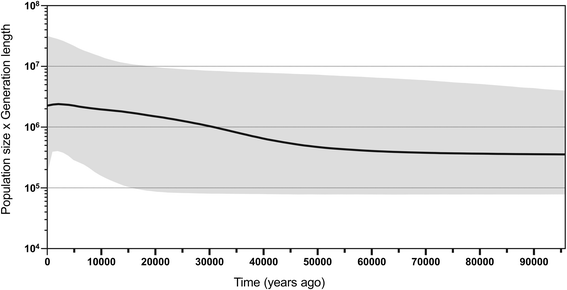Were sea level changes during the Pleistocene in the South Atlantic Coastal Plain a driver of speciation in Petunia (Solanaceae)?
- PMID: 25989835
- PMCID: PMC4438590
- DOI: 10.1186/s12862-015-0363-8
Were sea level changes during the Pleistocene in the South Atlantic Coastal Plain a driver of speciation in Petunia (Solanaceae)?
Abstract
Background: Quaternary climatic changes led to variations in sea level and these variations played a significant role in the generation of marine terrace deposits in the South Atlantic Coastal Plain. The main consequence of the increase in sea level was local extinction or population displacement, such that coastal species would be found around the new coastline. Our main goal was to investigate the effects of sea level changes on the geographical structure and variability of genetic lineages from a Petunia species endemic to the South Atlantic Coastal Plain. We employed a phylogeographic approach based on plastid sequences obtained from individuals collected from the complete geographic distribution of Petunia integrifolia ssp. depauperata and its sister group. We used population genetics tests to evaluate the degree of genetic variation and structure among and within populations, and we used haplotype network analysis and Bayesian phylogenetic methods to estimate divergence times and population growth.
Results: We observed three major genetic lineages whose geographical distribution may be related to different transgression/regression events that occurred in this region during the Pleistocene. The divergence time between the monophyletic group P. integrifolia ssp. depauperata and its sister group (P. integrifolia ssp. integrifolia) was compatible with geological estimates of the availability of the coastal plain. Similarly, the origin of each genetic lineage is congruent with geological estimates of habitat availability.
Conclusions: Diversification of P. integrifolia ssp. depauperata possibly occurred as a consequence of the marine transgression/regression cycles during the Pleistocene. In periods of high sea level, plants were most likely restricted to a refuge area corresponding to fossil dunes and granitic hills, from which they colonized the coast once the sea level came down. The modern pattern of lineage geographical distribution and population variation was established by a range expansion with serial founder effects conditioned on soil availability.
Figures




Similar articles
-
Geological and climatic changes in quaternary shaped the evolutionary history of Calibrachoa heterophylla, an endemic South-Atlantic species of petunia.BMC Evol Biol. 2013 Aug 29;13:178. doi: 10.1186/1471-2148-13-178. BMC Evol Biol. 2013. PMID: 23987105 Free PMC article.
-
Diversification of plant species in a subtropical region of eastern South American highlands: a phylogeographic perspective on native Petunia (Solanaceae).Mol Ecol. 2010 Dec;19(23):5240-51. doi: 10.1111/j.1365-294X.2010.04871.x. Epub 2010 Oct 28. Mol Ecol. 2010. PMID: 21040052
-
Phylogeography of the planktonic chaetognath Sagitta setosa reveals isolation in European seas.Evolution. 2004 Jul;58(7):1472-87. doi: 10.1111/j.0014-3820.2004.tb01728.x. Evolution. 2004. PMID: 15341150
-
Community genetics in the Northwestern Atlantic intertidal.Mol Ecol. 2002 Jul;11(7):1131-44. doi: 10.1046/j.1365-294x.2002.01510.x. Mol Ecol. 2002. PMID: 12074721 Review.
-
Marine Transgression in Modern Times.Ann Rev Mar Sci. 2024 Jan 17;16:55-79. doi: 10.1146/annurev-marine-022123-103802. Epub 2023 Jul 20. Ann Rev Mar Sci. 2024. PMID: 37339750 Review.
Cited by
-
A historical stepping-stone path for an island-colonizing cactus across a submerged "bridge" archipelago.Heredity (Edinb). 2024 Jun;132(6):296-308. doi: 10.1038/s41437-024-00683-4. Epub 2024 Apr 18. Heredity (Edinb). 2024. PMID: 38637723 Free PMC article.
-
Shades of white: The Petunia long corolla tube clade evolutionary history.Genet Mol Biol. 2024 Feb 12;47(1):e20230279. doi: 10.1590/1415-4757-GMB-2023-0279. eCollection 2024. Genet Mol Biol. 2024. PMID: 38385448 Free PMC article.
-
Integrating Paleodistribution Models and Phylogeography in the Grass-Cutting Ant Acromyrmex striatus (Hymenoptera: Formicidae) in Southern Lowlands of South America.PLoS One. 2016 Jan 6;11(1):e0146734. doi: 10.1371/journal.pone.0146734. eCollection 2016. PLoS One. 2016. PMID: 26734939 Free PMC article.
-
Contribution of WUSCHEL-related homeobox (WOX) genes to identify the phylogenetic relationships among Petunia species.Genet Mol Biol. 2016 Oct-Dec;39(4):658-664. doi: 10.1590/1678-4685-GMB-2016-0073. Epub 2016 Oct 20. Genet Mol Biol. 2016. PMID: 27768156 Free PMC article.
-
The xeric side of the Brazilian Atlantic Forest: The forces shaping phylogeographic structure of cacti.Ecol Evol. 2017 Oct 4;7(22):9281-9293. doi: 10.1002/ece3.3458. eCollection 2017 Nov. Ecol Evol. 2017. PMID: 29187968 Free PMC article.
References
-
- Bennett KD, Provan J. What do we mean by ‘refugia’? Quat Sci Rev. 2008;27:2449–2455. doi: 10.1016/j.quascirev.2008.08.019. - DOI
-
- Hewitt GM. Some genetic consequences of ice ages, and their role in divergence and speciation. Biol J Linn Soc. 1996;58:247–276. doi: 10.1111/j.1095-8312.1996.tb01434.x. - DOI
Publication types
MeSH terms
Associated data
- Actions
- Actions
- Actions
- Actions
- Actions
- Actions
- Actions
- Actions
- Actions
- Actions
- Actions
- Actions
- Actions
- Actions
- Actions
- Actions
- Actions
- Actions
- Actions
- Actions
- Actions
- Actions
- Actions
- Actions
- Actions
- Actions
- Actions
- Actions
- Actions
- Actions
- Actions
- Actions
- Actions
- Actions
- Actions
- Actions
- Actions
- Actions
- Actions
- Actions
- Actions
- Actions
- Actions
- Actions
- Actions
- Actions
- Actions
- Actions
- Actions
- Actions
- Actions
- Actions
- Actions
- Actions
- Actions
- Actions
- Actions
- Actions
- Actions
- Actions
- Actions
- Actions
- Actions
- Actions
- Actions
- Actions
- Actions
- Actions
- Actions
- Actions
- Actions
- Actions
- Actions
- Actions
- Actions
- Actions
- Actions
- Actions
LinkOut - more resources
Full Text Sources
Other Literature Sources

